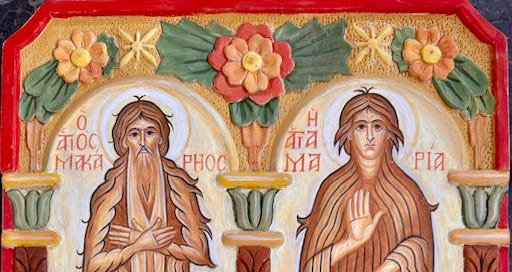In the Eastern and Western Christian traditions, St. Mary of Egypt (c. 344 — c. 421) is a greatly loved and venerated figure. In the Latin Church, she is commemorated on April 2 or April 9, depending on the locale. In the Orthodox and Byzantine Rite Catholic Churches, her feast day is April 1, and she is also celebrated on the Fifth Sunday of Lent. No doubt her story has been embroidered with legend (see the video below), but that she was a historical person, a model penitent venerated first by the desert monks and then by the universal Church, seems beyond dispute. In Christian art, she has been depicted as an old woman, adorned in a tattered cloak (given to her by the holy Abba Zosimas to cover her nakedness). This is usually how she is shown in Eastern Christian art. In the medieval Latin Church’s art, she is covered by her long flowing hair. In the icon below, I have adopted the Western depiction and rendered it in a Byzantine style. I have matched her with St. Macarios, an ascetic with a long flowing beard and also adorned with hair.
One can read more about St. Mary at the New Liturgical Movement website, which is an excellent resource. Below, I have embedded the 19-minute biography from Trisagion Films.
Once thou wast defiled with every impurity, but today through repentance thou hast become the Bride of Christ. Desiring the life of the angels, thou hast cast down the demons with the weapon of the Cross: therefore, O glorious Mary, thou wast made a bride of the kingdom.
In our hymns we praise thee now, all-venerated Mary, as the lamb and daughter of Christ. Sprung from the stock of the Egyptians, thou hast fled from all their errors and wast offered as a precious flower to the Church. In abstinence and prayer thou hast struggled above the measure of man’s nature, and so thou wast exalted by Christ; for through thy life and actions, Mary all-revered, thou wast made a bride of the heavenly Kingdom.
(Kontakion and Ikos, Canticle Six, Tone Three, Mattins, Fifth Sunday of Lent)




